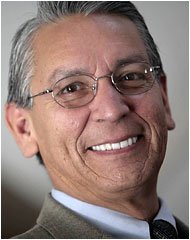This section of the SUNY Empire website is no longer being updated.
View current SUNY Empire Stories.
March 19, 2018
Kevin Gover, Director of the Smithsonian National Museum of the American Indian, Delivers Boyer Family Lecture: “Why Americans Should Unlearn Their History”

Starting with the Civil Rights movement in the 1950s and ‘60s, issues of racism, discrimination and poverty were often framed in black and white. But during this time, Native Americans were part of the same phenomena. Just as Rosa Parks sitting down on a bus sparked the Montgomery bus boycott, a pivotal event in the black civil rights narrative – the occupations of Alcatraz by a group called Indians of all Tribes in 1969 and Wounded Knee in 1973 by the American Indian Movement (AIM) sparked Native Americans to action.
Kevin Gover, director of the National Museum of the American Indian, part of the Smithsonian Institution in Washington, D.C., said that while agitation for black civil rights may have led the way, attention did eventually turn to Native Americans and poor people in general. “The Civil Rights movement made space for issues of Native Americans to be explored. There was a fair amount of Congressional activity, and black protest made room for all minority groups to come to the public consciousness,” he said.
Director of the museum since 2007, Gover – who is the keynote speaker for the Boyer Family Lecture at All College – will speak on education and the miseducation of Americans vis-a-vis the Native American. “The subject I want to address is that the way Americans learn history is not conclusive. American history can be learned from many perspectives,” he said. “It is not a matter of memorizing names, dates and events, but thinking, ‘What was it like to be alive in that particular moment?’ Once you begin to tell stories in diverse and inclusive ways, they get more interesting.” The title of Gover’s lecture is “Why Americans Should Unlearn Their History.”
Those not attending All College can view the lecture on ESC-TV at https://sunyempire.edu/esc-tv/.
Native Americans are the primary constituents of the museum, in terms of sharing their history, stories and artifacts. But the museum sees 1.6 to 1.8 million visitors per year, and most are not Indian.
Gover is a graduate of Princeton University’s Woodrow Wilson School (1978) and the University of New Mexico College of Law (1981). After clerking for U.S. District Judge Juan G. Buriaga, he joined a law firm, where his practice focused on representing Indian tribes, tribal agencies and Alaska Native corporations. With partners, he eventually started his own firm that specialized in federal Indian law. His advocacy brought him to the attention of the Clinton White House, and he was tapped to serve as assistant secretary for Indian Affairs in the U.S. Department of the Interior. After leaving that office, he returned to the practice of law.
There are many beloved stories, such as the First Thanksgiving, that are not quite accurate, Gover said. For example, most students in elementary school don’t learn about Squanto, one of the Indians who welcomed the Europeans and helped them acclimate. He was later captured and enslaved in Europe. By the time he returned to his native land, his whole village had been wiped out by smallpox.
Many things have improved recently, though, especially in the area of Indian scholarship. So many colleges and universities have opened departments of Native American history --or have otherwise included that history – that the volume of research has blossomed. “One cannot keep up with the volume; it’s overwhelming,” Gover said happily.
“Things have gotten dramatically better since I first got involved (in Indian rights) 40-plus years ago,” he said, noting more wealth and less ignorance and disease. Gover, who is a skeptic when it comes to reparations, recalled passage by Congress of the Indian Claims Act of 1946. Money was given per capita on the basis of the mid-1800s economy, and Indians felt they got “ripped off again.” For the thousands of acres of land taken by the U.S. government, Gover, the son of Indian rights activists, remembered that his family one year was able to get a new car.
There’s still a long way to go. Government officials at all levels, from local, state to federal, are charged with making decisions that concern the Indian populations, and often do so from a place of not having enough knowledge, Gover said.
The museum’s charge is to help all people “unlearn” fanciful stories concerning Native Americans and come to know the truth about the first peoples in North America.